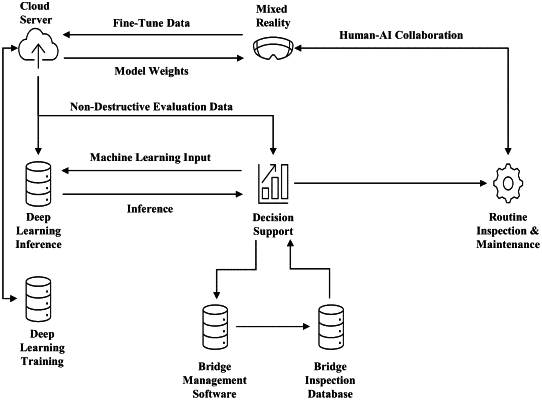| CPC G06T 7/0004 (2013.01) [G02B 27/0172 (2013.01); G06F 3/011 (2013.01); G06T 7/11 (2017.01); G06V 10/774 (2022.01); G06V 10/95 (2022.01); G02B 2027/014 (2013.01); G02B 2027/0138 (2013.01); G02B 2027/0141 (2013.01); G06T 2200/24 (2013.01); G06T 2207/20081 (2013.01); G06T 2207/30132 (2013.01); G06T 2210/12 (2013.01)] | 6 Claims |

|
1. A method of calculating a likelihood of a defect within a captured image of a structure using a hybrid system, the method comprising the steps of:
scanning an area surrounding a mixed reality headset to capture one or more images including possible defects;
suggesting, via the mixed reality headset, an area within the captured one or more images for an analysis;
receiving, via a user-input actuator in communication with the mixed reality headset, an input from a user to investigate the area;
capturing, via the mixed reality headset, an image of the area;
generating, via the mixed reality headset, a bounding box surrounding the image of the area, the bounding box including a plurality of boundaries;
projecting, via the mixed reality headset, an object onto the bounding box surrounding the image of the area;
transmitting, via the mixed reality headset, the bounding box surrounding the image of the area and the projected object to a server;
segmenting, via the server, the image within the bounding box by creating a plurality of prediction vectors within the image;
comparing, via the server, the segmented image with a plurality of images from a trained data set by comparing the plurality of prediction vectors and the projected object to the trained data set;
calculating, via the server, a likelihood of a defect within the segmented image based on the comparison with the trained data set; and
transmitting, via the server, the calculated likelihood of the defect to the mixed reality headset.
|